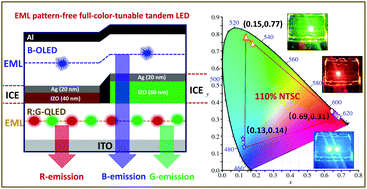Quantum-dot and organic hybrid tandem light-emitting diodes with color-selecting intermediate electrodes for full-color displays†
Abstract
The immaturity of the color patterning technology and the poor stability of blue (B) quantum-dots are two of the challenges that restrict the development of quantum-dot electroluminescence displays. In this work, we demonstrate a hybrid tandem light-emitting diode (LED), in which a yellow (Y) quantum-dot LED and a B organic LED are vertically connected using an IZO/Ag intermediate electrode. The transparent IZO sets the resonance wavelength of the Y-QLED and thus selectively converts the yellow emission into R or G emission, while the semi-reflective Ag enhances the optical interference of the B LED and hence improves the color saturation of the B emission. Enabled by the multi-functionalities of color-selection and color-enhancement of the intermediate electrode, the tandem LED can emit independently controllable R, G and B colors with a high color gamut of ∼110% NTSC without the need to pattern the light-emitting layers. The demonstrated tandem LED could provide a promising way for the realization of emitting-layer-patterning-free, color-filter-free and wide-color-gamut electroluminescence displays.



 Please wait while we load your content...
Please wait while we load your content...